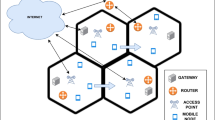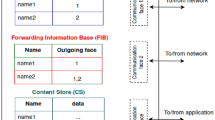Abstract
Spectral efficiency is significantly compromised when different users download same content over a wireless link. Especially in a peer-to-peer (PTP) network, this may also lead to congestion and unfair usage of the links by users with superior link conditions. In this paper, in order to address the above mentioned problems a socially fair user scheduling algorithm (SFUSA) for a PTP is proposed. The proposed algorithm selects a leader from the PTP who will download data and share it within the PTP using a short range ad-hoc wireless network. In order to select the leader SFUSA takes into consideration the traffic conditions in the link of individual users from the data access point along with social fairness factor of the users. It is shown through simulations that the proposed algorithm solves the problem of congestion at the data access point, along with increased retention of peers in a PTP with enhanced user satisfaction.











Similar content being viewed by others
References
Ramya Catherine M, Bijolin Edwin E (2013) A survey on recent trends in cloud computing and its application for multimedia. Int J Adv Res Comput Eng Technol 2(1):304–309
Pagani M, Fine CH (2008) Value network dynamics in 3G-4G wireless communications: a systems thinking approach to strategic value assessment. J Bus Res 61(11):1102–1112
Megyesi P, Szabo G, Molnar S (2015) User behavior based traffic emulator: a framework for generating test data for DPI tools. Comput Netw 92(1):41–54
Ristanovic N, Le Boudec J-Y, Chaintreau A, Erramilli V (2011) Efficient offloading of 3G networks. In; IEEE 8th International conference on mobile adhoc and sensor systems (MASS), pp 202–211
Damiani E, Vimercati D, Paraboschi S, Samarati P, Violante F (2002) A reputation-based approach for choosing reliable resources in peer-to-peer networks. In: 9th ACM conference in computer and communications security, pp 207–216
Subramanian R, Goodman BD (2005) Peer to peer computing the evolution of a disruptive technology. In: Idea Group (IGI), pp 28–59
Feldman M, Lai K, Stoica I, Chuang J (2004) Robust incentive techniques for peer-to-peer networks. In: 5th ACM conference on electronic commerce, pp 102–111
Pouwelse J A, Garbacki P, Wang J, Bakker A, Yang J, Iosup A, Epema DH J, Reinders M, van Steen M R, Sips H J (2008) Concurrency and computation practice and experience. Recent Adv Peer-to-Peer Syst Secur 20(2):127–138
Cheng X, Dale C, Liu J (2008) Statistics and social network of youtube videos. In: Quality of service IWQoS IEEE, pp 229–238
Mehra A, Kilduff M, Brass D J (1998) At the margins: a distinctiveness approach to the social identity and social networks of underrepresented groups. Acad Manag 41(4):441–452
Lin X, Cheung CMK, Lee M K O, Chen H (2009) How to keep members using the information in a computer-supported social network. Comput Human Behav 25(5):1172–1181
Seo J, Kwon T, Leung VCM (2013) Social groupcasting algorithm for wireless cellular multicast services. IEEE Commun Lett 17(1):47–50
Saroiu S, Gummadi PK, Gribble SD (2002) Measurement study of peer-to-peer file sharing systems. Multimid Comput Network 4673(156)
Qiu D, Srikant R (2004) Modelling and performance analysis of BitTorrent-like peer-to-peer networks. ACM SIGCOMM Comput Commun Rev 34(4):367–378
Sherwood R, Braud R, Bhattacharjee B (2004) Slurpy: a coperative bulk data transfer protocol. In: IEEE INFOCOM
Carlsson N (2006) Scalable download protocols. In: Doctoral dissertation ACM digital library, pp 1–161
Sabrina Lin W, Vicky Zhao H, Ray Liu K J (2009) Incentive cooperation strategies for peer-to-peer live multimedia streaming social networks. IEEE Trans Multimed 11(3):396–412
Araniti G, Condoluci M, Iera A (2012) Adaptive multicast scheduling for HSDPA networks in mobile scenarios. In: IEEE International symposium, broadband multimedia systems and broadcasting (BMSB), pp 1–5
Araniti G, Condoluci M, Iera A (2013) Adaptive resource allocation to multicast services in LTE systems. IEEE Trans Broadcast 59(4):658–664
Chang Z, Ristaniemi T, Niu Z (2014) Energy efficient user grouping and scheduling collaborative mobile cloud. Commun (ICC) IEEE:4281–4286
Hox F, Cai L X, Ho P-H, Shen X, Zhang J (2009) A cooperative multicast scheduling scheme for multimedia services in IEEE 802.16 networks. IEEE Trans Wireless Commun 8(3):1508– 1519
Rong B, Hafid A (2010) Cooperative multicast for mobile IPTV iver wireless mesh networks: the relay-selection study. IEEE Trans Veh Technol 59(5):2207–2218
Dong L (2009) Distributed relational data sharing based on P2P. In: International conference on new trends in information and service science, NISS, pp 378–383
Akyildiz I F, Weilian S, Sankarasubramaniam Y, Cayirci E (2002) A survey on sensor networks. IEEE Commun Mag 40(8):102– 114
Friedman R, Kogan A, Krivolapov Y (2012) On power and throughput tradeoffs of WiFi and bluetooth in smartphones. IEEE Trans Mob Comput 12(7):1363–1376
Upadrashta Y, Vassileva J, Grassmann W (2005) Social networks in peer-to-peer systems. In: 38th Annual Hawaii international conference on system sciences, pp 200c
Yang S JH, Chen IYL (2008) A social network-based system for supporting interactive collaboration in knowledge sharing over peer-to-peer network. Int J Human-Comput Stud 66(1):36–50
Meguerdichian S, Koushanfar F, Qu G, Potkonja M (2001) Exposure in wireless ad-hoc sensor networks. In: 7th ACM international conference Mobicom, pp 139–150
Yang M, Chen H, Zhao B Y, Dai Y, Zhang Z (2004) Deployment of a large-scale peer-to-peer social network. In: WORLDS’04 PAPER
Androutsellis-Theotokis S, Spinellis D (2004) A survey of peer-to-peer content distribution technologies. ACM Comput Surv 36(4):335–371
Buchegger S, Datta A (2009) A case for P2P infrastructure for social networks - opportunities & challenges. In: WONS 6th international conference, pp 161–168
Chao I, Ardaiz O, Sanguesa R (2009) A group selection pattern applied to grid resource management. Syst J IEEE 3(1):91–103
Mao H, Feng W, Zhao Y, Ge N (2014) Joint social-position relationship based cooperation among mobile terminals. IEEE Commun Lett 18(2):2165–2168
Lua EK, Crowcroft J, Pias M (2005) A survey and comparison of peer-to-peer pverlay network schemes. IEEE Commun Surv 7(2)
Thien L M, Razak NA, Jamil H (2012) Freindship quality scale: conceptualization, development and validation. In: Joint AARE APERA international conference, pp 1–14
Anderson TW, Amemiya Y (1988) The asympotic normal distribution of estimators in factor analysis under general conditions. Ann Stat 16(2):759–771
Azzalini A, Capitanio A (1999) Statistical applications of the multivariate skew normal distribution. J R Stat Soc Series B (Stat Methodol) 61(3):579–602
Snijders TAB, Baerveldt C (2010) A multilevel network study of the effects of delinquent behavior on friendship evolution. J Math Sociol 27(2–3):123–151
Bustamante FE, Qiao Y (2004) Friendships that last: peer lifespan and its role in P2P protocols. Web Content Cach Distrib 6:233– 246
Abrahams SC, Keve ET (1971) Normal probability plot analysis of error in measured and derived quantities and standard deviations. Acta Crystallograph Cryst Phys Diff Theor Gen Crystallograph 27(2):157–165
Azzalini A (1985) A class of distributions which includes the normal ones. Scand J Stat 12(2):171–178
Rahman R, Meulpolder M, Hales D, Pouwelse J (2010) Improving efficiency and fairness in P2P systems with effort-based incentives. IEEE Int Conf Commun:1–5
Mascolo S (1999) Congestion control in high-speed commmunication networks using the Smith principle. Automatica 35:1921–1935
Krasteva R, Boneva A, Georchev V, Stoianov I (2005) Application of wireless protocols bluetooth and zigbee in telemetry system development. In: Central laboratory of mechatronics and instrumentation
Dhawan S (2007) Analogy of promising wireless technologies on different frequencies: bluetooth, wifi, and wimax. In: 2nd International conference on wireless broadband and ultrawideband communications, pp 14
Raniwala A, Gopalan K, Chiueh T (2004) Centralized channel assignment and routing algorithms for multi-channel wi reless mesh networks. Mob Comput Commun Rev 8(2):50–65
Hu J, Yang L, Hanzo L (2014) Cooperative multicast aided picocellular hybrid information dissemination in mobile social networks: delay/energy evaluation and relay selection. In: IEEE Wireless communications and networking conference (WCNC), pp 1–6
Arenas A, Diaz-Guilera A, Guimera R (2001) Communication in networks with hierarchical branching. Phys Rev Lett 86:3196
Islam MS, Abedin MZ, Das S (2014) Mobile wireless peer-to-peer network with higher end-to-end throughput and lower end-to-end delay. Amer J Eng Res 3(2):8–21
Blum JJ, Eskandarian A, Hoffman LJ (2004) Challenges off intervehicle ad hoc networks. IEEE Trans Intell Transp Syst 5(4):347–351
Qiu D, Srikant R (2004) Modeling and performance analysis of BitTorrent-like peer-to-peer networks. ACM SIGCOMM Comput Commun Rev 34(4):367–378
Pouwelse J, Garbacki P, Epema D, Sips H (2005) The Bittorrent P2P file-sharing system: measurements and analysis. Peer-to-Peer Syst IV 3640:205–216
Asvanund A, Clay K, Krishnan R, Smith MD (2004) An empirical analysis of network externalities in peer-to-peer music-sharing networks. Inf Syst Res 15(2):155–174
Wang J, Yeo C, Prabhakaran V, Ramchandran K (2007) On the role of helpers in peer-to-peer file download systems: design, analysis and simulation. In: IPTPS, pp 1–6
Bernstein DS, Feng Z, Levine BN, Zilberstein S (2003) Adaptive peer selection. Peer-to-Peer Syst II 2735:237–246
Author information
Authors and Affiliations
Corresponding author
Rights and permissions
About this article
Cite this article
Sharma, N., Das, S. Social fairness and channel loading effects in peer-to-peer connected networks. Peer-to-Peer Netw. Appl. 11, 450–461 (2018). https://doi.org/10.1007/s12083-017-0543-y
Received:
Accepted:
Published:
Issue Date:
DOI: https://doi.org/10.1007/s12083-017-0543-y




